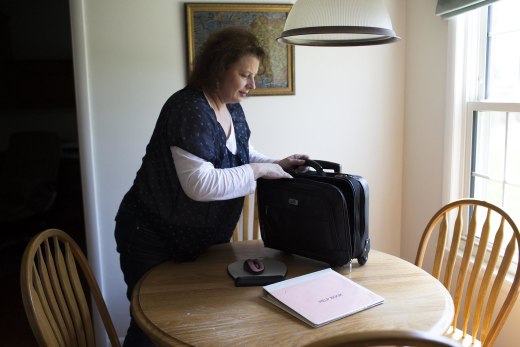IN PLAIN SIGHT
 MADDIE MCGARVEY / FOR NBC NEWS
MADDIE MCGARVEY / FOR NBC NEWSFor Many Americans, 'Temp' Work Becomes Permanent Way of Life
BY MARTHA C. WHITE
For Americans who can’t find jobs, the booming demand for temp workers has been a path out of unemployment, but now many fear it’s a dead-end route.
With full-time work hard to find, these workers have built temping into a de facto career, minus vacation, sick days or insurance. The assignments might be temporary — a few months here, a year there — but labor economists warn that companies’ growing hunger for a workforce they can switch on and off could do permanent damage to these workers’ career trajectories and retirement plans.
“It seems to be the new norm in the working world,” said Kelly Sibla, 54. The computer systems engineer has been looking for a full-time job for four years now, but the Amherst, Ohio, resident said she has to take whatever she can find.
“I know a lot of people who are doing this temping. It seems to be the way this is going,” she said.
Sibla’s husband, 67, got a buyout offer from his former employer and is now retired, but she has minimal retirement savings in her own name. “When you’re working as a temp you don’t get any of that. Nothing,” she said. The couple is downsizing to a smaller home and trying to sell the one they live in now to reduce expenses.
“There are a lot of perverse incentives for employers to use temps.”
“You don’t get any benefits to speak of, you only get paid for what you work … no sick time, no paid vacation,” said Brian Dupuy, a computer technician in Des Moines who lost his last full-time job five years ago and has been temping since 2011.
Dupuy, 56, said he’s paid hourly, and the rate comes to about 40 percent less than he was earning at his last full-time job. “After a year, they’ll sign you up for a 401(k) but the salary is so low you have trouble making ends meet to begin with,” he said.
Economists say it’s typical for temporary hiring to rise initially as the economy recovers, before businesses are ready to commit to hiring full-time employees. But Susan Houseman, senior economist at Upjohn Institute for Employment Research, said the current pattern doesn’t fit historic norms.
“Right now we’re seeing something interesting,” she said. “We’ve seen it surpass its previous highs, so it looks like there could be a structural shift going on, too. There’s a reason to believe we might see some increase in the use of temporary help in general.”
In March, the temp industry added 28,500 jobs, and about 2.8 million workers are employed currently in temporary or contract positions, according to the Bureau of Labor Statistics. This is a little more than 2 percent of the workforce, a peak last reached in April 2000, said Steve Berchem, chief operating officer of the American Staffing Association, an industry trade group.
Berchem cautioned that drawing conclusions from one month or even a few months’ worth of data could be misleading because the BLS frequently revises its data, but he said the shift to companies using more temporary workers is already under way.
“We argued when the recovery began that there would be a structural shift,” he said. “We were hearing that from members who were hearing that from their clients, (that) they were more likely to use temp and contract workers.”
“There are a lot of perverse incentives for employers to use temps,” said Erin Hatton, an assistant professor of sociology at the State University of New York, Buffalo, and author of "The Temp Economy: From Kelly Girls to Permatemps in Postwar America." For one thing, it’s cheaper. Using temporary labor lets companies avoid the cost of providing benefits like health insurance, workers’ comp, paid sick leave and the like.
“It allows them to increase or reduce their workforce more easily, and in an uncertain environment, that can be very valuable to the firm,” Houseman said.
More kinds of businesses seem to be drawing that conclusion, as industries not thought of as traditional temp work territory are using more contract workers. Hatton pointed out that adjunct college professors face much of the same uncertainty and lower wages than their full-time counterparts. And manufacturing companies make up around 40 percent of the current demand for temp workers, Houseman said.
“In the government data, you see that 17 percent of assembly line workers are hired through the staffing industry,” Houseman said.
With organized labor losing its clout, there’s little to check companies’ ability to shed workers the moment they perceive an economic chill, said Eileen Appelbaum, a senior economist at the Center for Economic and Policy Research. “In the private sector there’s no counterbalancing power,” she said. “The decisions are almost costless to them.”
Appelbaum added that domestic outsourcing — when companies contract with third-party firms to handle everything from their janitorial to their payroll services needs — is on the rise.
“Your job is dispensable. That’s why you’re a temp.”
It’s all part of a broader shift to an everyone-for-themselves workforce, labor economists say. Business services firm MBO Partners says there were 17.7 million independent workers last year, up 10 percent from 2011.
Berchem called this shift in the labor market a “win-win” for companies as well as workers. “We’ve seen an increase in workers preferring flexibility,” he said. “Family is a big priority for temporary and contract employees and they prefer the flexibility such work allows.”
Lynn Monaghan, 33, began temping after a transition away from her former career in event planning and says there are pros and cons.
“The pros are, it’s given me a great amount of flexibility,” she said of her current job, which is also nearby where she lives in suburban Boston. “Being a working mother, that has been really beneficial to me. There’s less pressure,” she said.
But flexibility is relative.
“There is certainly a small segment of the workforce ... that does want real flexibility in their lives. The thing is, though, that temp work is very flexible for employers and not that flexible for workers,” Hatton said. “It gives them a profound sense of insecurity.”
As a temp, even something as innocuous as personalizing a workstation can be a gamble. With her unemployment benefits exhausted and “no calls whatsoever,” Dayton, Ohio-area resident Ronda Roberts said she took a temp job in December 2012 doing clerical work that paid a quarter of what she previously made as a developer of training materials. “I kind of felt like I didn’t have a choice,” said Roberts, 55.
A year later, even that rug was pulled out from under her. Roberts said she took a rare sick day, only to get a phone call from the temp agency that evening, telling her that her contract had been ended, effective immediately.
When she asked if she could retrieve her computer case and other personal items, the agency told her she wasn’t allowed back into the office where she had worked for roughly a year, and that she had to wait for the company’s corporate human resources department to contact her.
In the end, it took Roberts two months of waiting and an hour’s drive to the company’s headquarters to get her things back. “If I ever got a temp job again, I would not leave anything on site,” she said. “It bothers me that I wouldn’t be able to go and get my own things.”
 MADDIE MCGARVEY / FOR NBC NEWS
MADDIE MCGARVEY / FOR NBC NEWS
Roberts said she had gotten along well with her full-time co-workers and that she felt like part of the team, but her abrupt dismissal and the hoops she had to jump through to retrieve her belongings reminded her of her outsider status. “Your job is dispensable. That’s why you’re a temp,” she said.
This is just one of many ways Hatton said temp workers are marginalized in corporate culture. “There’s a very deep level of unfairness,” she said. “Those workers feel profoundly bitter.”
“When you’re just a contractor at a company … your ID badge is a different color. People treat you differently. They say they don’t, but they just do,” Sibla said.
More alarming to economists, long-term temps also miss out on the opportunity to develop a nest egg for a comfortable retirement.
“It’s almost entirely the burden of the individual,” said Kevin Cahill, a labor economist with the Sloan Center on Aging & Work at Boston College.
The potential hit to Social Security benefits is two-fold, he said. Since Social Security benefits are based on your earnings over your work history, both low-paying temp work or a gap in employment — a combination many of today’s “permatemps” face — can drag down a worker’s future payments.
These workers also may not have access to a corporate 401(k) plan. Even if they do, they might not be paid enough to be able to put any away for retirement. There’s certainly no employer match.
“Folks who turn to temporary employment because full-time employment is lacking have been hit extra hard. They’ve lost time to accumulate savings and could very well bleed down their savings during their job search.”
This is what happened to Dupuy, who said he used his 401(k) funds to stay afloat during his unemployment. “I figure I’m going to be working way beyond 65 or 67 or whatever it is these days,” he said. “I just know it’s going to be really hard.”
This has broad effects, Hatton warned, not just on the legions of temp workers today, but on the next generation. Their tenuous employment situation can make it harder for them to send their children to college, she said. “The effects ripple out.”
No comments:
Post a Comment
Thanks for commenting. Your comments are needed for helping to improve the discussion.